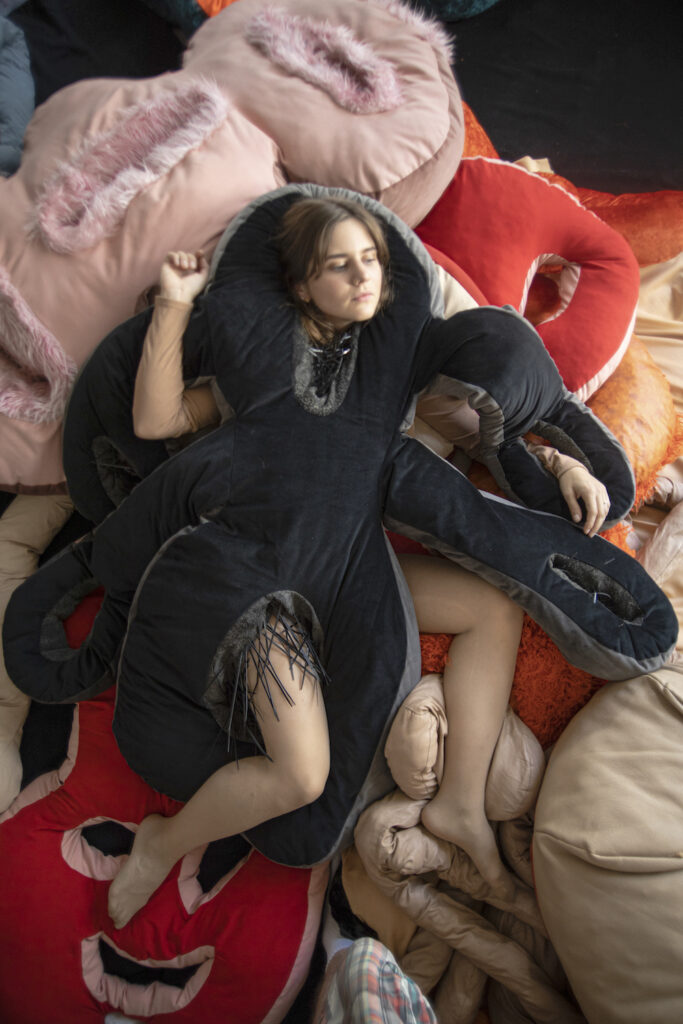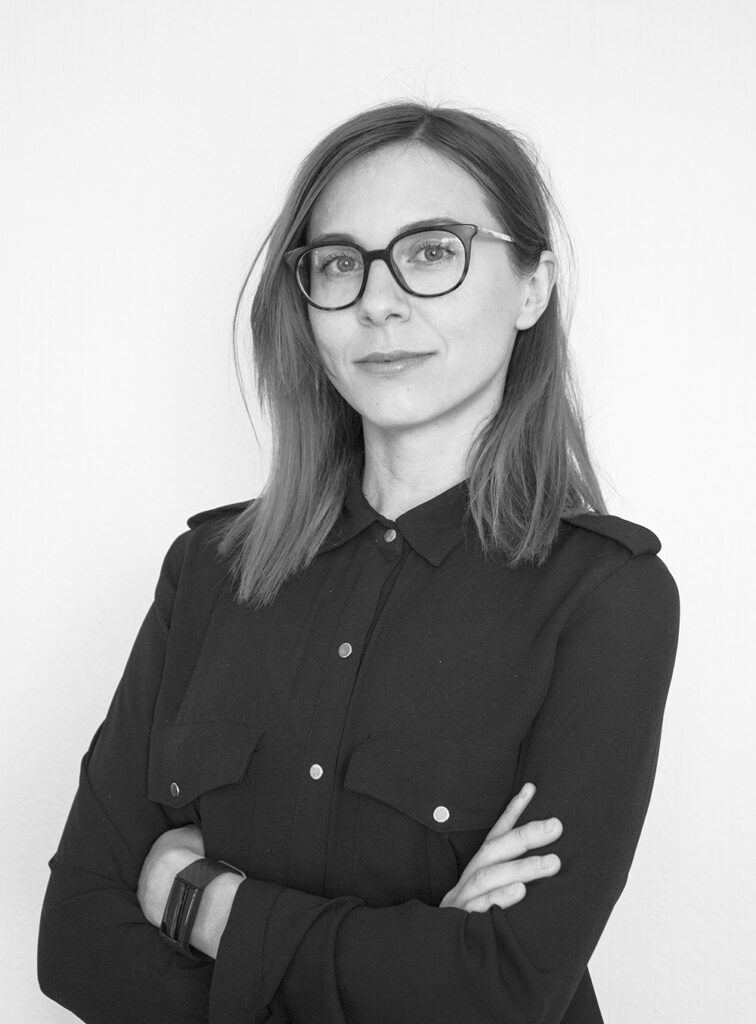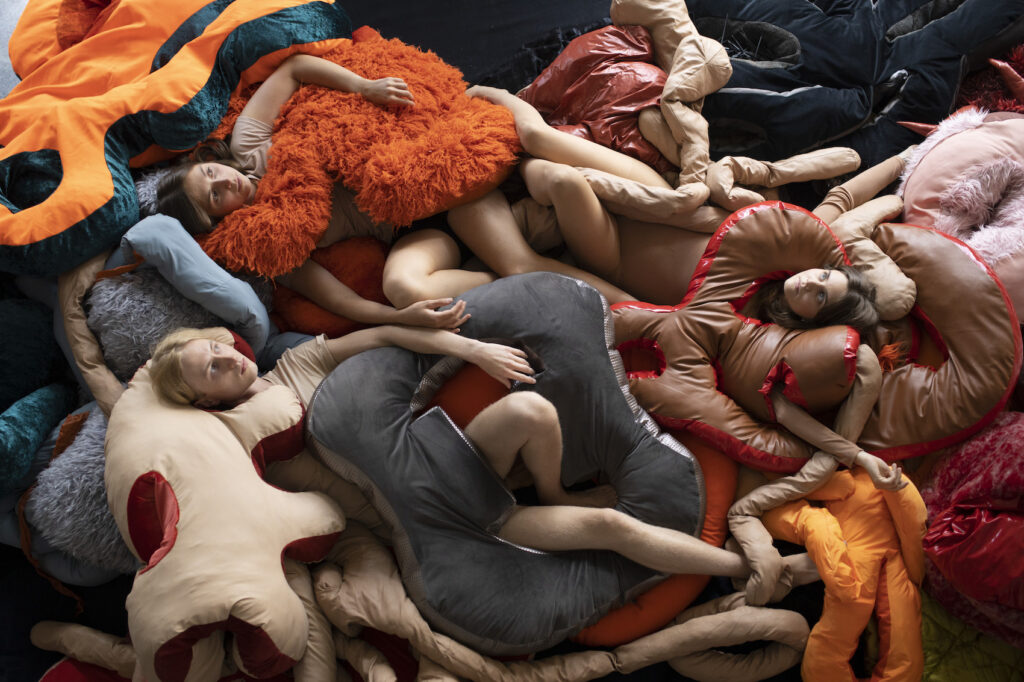‘Rhizopia’ stands for an environment that stimulates the senses to enable losing boundaries between oneself and the rest, introspection and testing different ways of togetherness.
Objects of convergence
According to Aristotle, tactility is the only sense without which animals could not survive. The ability to sense touch and react accordingly is the foundation of life for sensory beings, which is how we can deduce that it may also be one of the fundamental senses for humans.1 Our primary contact with the outer world materialises through maternal touch—before we ever see, smell, hear or taste, the quality of this very first tactility determines the entire direction of our life.2 In infancy we learn to sense our boundaries starting with what is closest to us—our hands and mouth. Touch enables us to position ourselves here, and understand that we exist. By the end of the first year of life, a child becomes attached to a meaningful object, be it a soft toy, blanket, pillow, or the like. According to psychoanalysist Donald W. Winnicott (1896–1971), the child uses these transitory objects to join their subjective reality with a shared reality, causing the transitory object to contain elements of both the self and of the environment. As the child develops and the scope of the faculties of the ego expands, the child grows apart from the object, and its meaning dissipates. Despite that, Winnicott emphasises that, the object is not forgotten, repressed or mourned: instead it is distributed throughout the entire cultural field of the person’s adult life.3
For adults, transitory objects are replaced by comfort objects that fulfil a similar purpose: to redure anxiety and tension, and offer support. Adults often turn to weighted blankets or those familiar soft toys they used to cling to in childhood. More often than not, however, these objects are no longer purposefully owned in adult years since their usefulness is not acknowledged.
These considerations led me to the question if through objects it were possible to create an environment that would act as interface between the internal and external worlds, and offer new ways to sense space, in addition to what we have grown used to? Would we be able to acknowledge space and the incipient experience in a more versatile way? While setting up this task I reached the conclusion that an environment like that should reflect the soft, comforting and encompassing nature of the transitory objects while also enabling connecting people physically. I arrived at the concept of Rhizopia.

Rhizopia
Rhizopia, aka rhizomatic utopia is a derivation of the words rhizome, meaning non-hierarchical information network, visually and mentally also linked with mushroom mycelium, and utopia, a hypothetical idea of an ideal society envisioned by Thomas More in the 16th century. Combined, they form a new type of rhizomic sensory space.
Rhizopia is made up of tactile human-sized sculptural elements that activate all sensory organs simultaneously. Three-dimensional soft objects joined together by extremely versatile materials and sewn in a way that enables interweaving each module with the others, creating a solid mass of objects and humans. The objects are mostly filled with soft volumous matter such as cotton, plastic, straw, polyurethane, springs, soil, etc. The visual identity of the objects is not conducive to the kind of sensation they might produce upon touch. An abundance of material and form such as this requires active haptic interfacing with the environment, merely looking at it will not unfold the potential of Rhizopia.
Internal/external
Rhizopia is a playground for adults. Tactile communication comes naturally for children and adolescents in their growing years, but adults have been left in a somewhat fragile state in this regard—smart devices have taken over the role of tactile stimulators yet provide little feedback for the body. Practices employing the more imaginary faculties of the mind have been forced under the category of ‘leisure’ and tend to succumb to more profitable functions. Adults are as if encoded with a belief that objects suitable for relating with ought to be ‘serious’, otherwise their purpose is too childlike. That very supposition is what inspired the need to test and see if it is possible to change it.
The haptic modality functions on the borderline between the internal and external—it is possible through tactility to elicit sensations of repulsion or pleasure that are closely tied to memory. Touch carries a potent emotional charge, and fetishes and fantasies are channelled through it. The body’s somatosensory4 system links skin perception with the brain, body and external world, associating body-awareness and self-reflexivity. Perceiving a tactile object is like taking a dive into the unknown, an attempt to surface associations and memory images associated with the haptic sense.
The objective of differing rhizopic objects is namely to call forth these sensations or memory-related images. Associations and feelings vary—some are disgusted by filmy, shiny and sticky surfaces, others are very much attracted to them. Some of the visitors to Rhizopia were taken back to childhood, imagining meadows and horses gallopping across them (the association was brought about by the smell of hay), others felt like they were in their mother’s womb. Abundant use of both captivating as well as repulsive materials enables expression of varying sentiments.

What if?
In addition to enabling self-reflection, the purpose of Rhizopia is to test different ways of being together. The central idea is to obscure the boundaries of selfhood through spatial practice, surpassing the opposition between object and subject, abandoning the ‘other’. That is to say, renouncing the differentiation between the construed self and the non-self outside of that realm. It is an organic environment with a capacity to initiate social interaction and turn attention to the connections between internal and external space.
Rhizopia is a perpetually changing creation that functions through the medium of abundant, diversified form to empower us to imagine different ways of being. A mental exercise like that creates possible what-if-scenarios, prompting interest toward what is to come or what could have been had we chosen a different path. What if: instead of rigid quadrangular furniture, the meeting rooms in bank buildings were filled with soft organic forms? what shape would interaction take in a room without specific hierarchical plan where participants are equally intertwined with the environment? what kind of ideas would emerge there? what could the world be like? Even if the idea may seem absurd, imagining possible future scenarios is of key importance in order to materialise positive changes. Rhizopia provides the freedom to improvise because an environment that activates the different senses may also inspire imagination.
The main idea behind Rhizopia is that to a lesser or greater degree we are all searching for ways to lose ourselves in something bigger than ourselves. Being constantly overtaken by one’s own thought constructs builds anxiety and exhaustion, therefore, momentary unselfing allows one to become liberated, lose one’s sense of time and space, and feel a oneness with the surrounding world. Philosopher Eik Hermann has addressed this topic by poignantly introducing the concepts of ‘oceanic’ and ‘on-the-palm’ in the context of spatial awareness. In a nutshell, on-the-palmrepresents a way of sensing the surroundings from a bystander’s analysing point-of-view. We regard the objects at hand as clearly distinct from us, we are able to categorise them, we are mentally enveloping and enclosing them. Oceanic, on the other hand, signifies a state of being surrounded by something, loss of boundaries and giving of oneself over to the power of space.5
Eik Hermann writes: ‘Thus we can say that space (in the strict sense of the word) cannot be perceived. To perceive space , one of the two ends of the relationship of perception (the subject vs object) needs to give in—when we encompass space (turning it into a unified object), we make it perceivable but it ceases to be space; yet, when we experience space as space, we cease to be selves (unified subjects)’.6
During this troubled and stressful time, Rhizopia provides the conditions for at least a short-term loss of self—to be oceanically enveloped and safe. It builds on the acknowledgment that when strict boundaries between the self and the rest are lost, the endless combinations of ambivalent objects become windows to introspective views. The objects found there may substitute comfort objects, and connect the inner world with the outer world. Renouncing the self can also mean finding contact with another.

KADRI LIIS RÄÄK is a freelance artist and designer whose passion is creating palpable experiences and studying the related phenomena.
Photos: Harry Tiits.
Published: Maja 101-102 (summer-fall 2020) Interior Design.
1 Alex Purves, What and where is touch? – Touch and the ancient senses. New York: Routledge, 2018, lk 1.
2 Jan Švankmajer, Touching and Imagining: An Introduction to Tactile Art. I. B. Tauris, 2014, lk xxi.
3 Donald Winnicott, The Family and Individual Development. London: Tavistock, 1965, lk 143.
4 Somatosensory systems are part of the sensory nervous system. The somatosensory system is a complex system of neurons and neural pathways that reacts to changes on the surface or inside the body. Contemporary literature regards touch as a modality of somatosensory perception.
5 Eik Hermann. ‘Krista Mölder’s Air in the Making’. —Between the Archive and Architecture. Neeme Külm, Krista Mölder, Taavi Talve. Tallinn: KUMU Publishers, 2016, pp 22.
6 ibid, pp 24.





